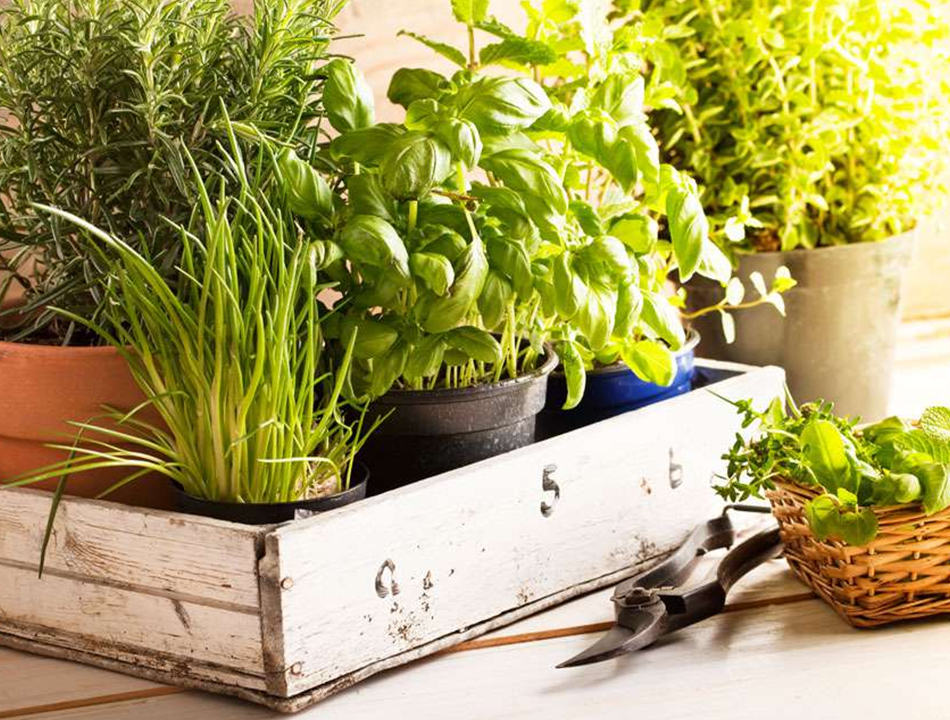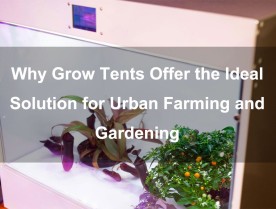
As the vibrant tapestry of summer begins to fade and the days gradually grow shorter, nature's canvas transforms into a breathtaking masterpiece of warm, earthy hues. While many may bid farewell to their outdoor gardens, autumn marks the perfect time to embark on an alternative horticultural journey – the art of growing indoors. In this season of change, we find ourselves presented with a myriad of reasons why autumn is indeed the perfect time to embrace the world of indoor gardening. From the cozy ambiance it creates to the bountiful harvests it can yield, let us delve into the enchanting world of indoor gardening and explore why autumn is the ideal season to nurture your green thumb within the comfort of your home.
The Challenges You May Meet When Growing Outdoors

1. Unpredictable Weather:
Autumn is known for its fickle weather patterns, characterized by fluctuating temperatures, sudden cold snaps, and unexpected rain or frost. These meteorological variations pose a significant challenge for outdoor gardeners. Plants that thrived during the warm summer months may struggle to adapt to the chilly evenings and chilly mornings of Autumn. And frost can be particularly devastating, as it can damage or even kill sensitive plants. Gardeners must remain vigilant and take precautions such as covering delicate plants or bringing them indoors during cold snaps to protect their green companions from the unpredictable Autumn weather.
2. Shortened Daylight Hours:
As Autumn progresses, daylight hours dwindle, and the sun's intensity decreases. This reduction in sunlight can hinder the growth and development of many plants. Photosynthesis, the process by which plants convert sunlight into energy, becomes less efficient, resulting in slower growth rates and smaller yields. Outdoor gardeners may need to consider supplementary lighting solutions, such as artificial LED grow lights, to provide their plants with the necessary illumination to thrive during the shorter Autumn days.
3. Pest and Disease Pressure:
Autumn brings with it a surge in pest and disease activity. Many garden pests, such as aphids, caterpillars, and snails, become more active in the cooler temperatures of Autumn. Additionally, the changing weather can create ideal conditions for the development of fungal diseases like powdery mildew. Outdoor gardeners must be vigilant in monitoring their plants for signs of infestations or disease and take proactive measures, such as using organic pesticides or practicing good garden hygiene, to protect their crops from these threats.
4. Soil and Nutrient Challenges:
Autumn can present challenges related to soil quality and nutrient availability. Cold and wet weather can lead to soil compaction and poor drainage, which can adversely affect root health and plant growth. Additionally, as the growing season winds down, plants may deplete the available nutrients in the soil. To address these challenges, gardeners can incorporate organic matter into the soil to improve its structure and fertility and may need to provide additional fertilization to ensure their plants have access to essential nutrients.
5. Limited Crop Variety:
In Autumn, the range of crops that can be successfully grown outdoors narrows. Many warm-season vegetables and herbs, such as tomatoes and basil, will struggle or fail to thrive in the cooler temperatures of Autumn. Gardeners may need to adjust their planting choices to include cold-hardy vegetables like kale, carrots, and spinach, limiting the variety of crops they can cultivate during this season.
The Benefits of Growing Indoors in Autumn

1. Temperature Control:
One of the foremost benefits of growing indoors during Autumn is the ability to maintain a consistent and controlled environment for your plants. While outdoor temperatures fluctuate dramatically during this season, indoor growers can provide a stable and ideal climate. This means you can protect your plants from sudden frosts or temperature drops, ensuring they thrive in a cozy, controlled setting.
2. Extended Growing Season:
Growing indoors allows you to extend the growing season well beyond what is possible outdoors in Autumn. You're not bound by the decreasing daylight hours or unpredictable weather conditions. With the right indoor setup and artificial lighting, you can cultivate a wide variety of crops, including herbs, leafy greens, and even certain fruiting plants, well into the colder months.
3. Protection from Pests and Disease:
Autumn brings a surge in pest and disease activity outdoors, but indoor gardening provides a protective barrier against these threats. You have more control over the cleanliness of your growing environment, reducing the risk of infestations or disease outbreaks. This means fewer worries about battling garden pests or dealing with widespread plant illnesses.
4. Enhanced Pest Management:
For those who've struggled with outdoor pests during the growing season, moving your plants indoors in Autumn offers a unique opportunity for targeted pest management. You can inspect each plant closely, implement organic pest control methods, and prevent any infestations from spreading. This focused approach can lead to healthier and more robust plants.
5. Energy Efficiency:
Indoor gardening can be energy-efficient, especially in the cooler months of Autumn. The controlled environment allows you to optimize heating and lighting systems for plant growth. With advancements in energy-efficient grow lights and heating technologies, you can minimize energy consumption while maximizing plant growth and productivity.
6. Consistent Harvests:
Indoor gardening in Autumn offers the advantage of a more predictable harvest schedule. Unlike outdoor gardening, where weather-related setbacks can delay or damage crops, indoor growers have greater control over the timing and quality of their harvests. This consistency can be particularly valuable for those who rely on homegrown produce year-round.
7. Exploration of Unique Plants:
Growing indoors during Autumn provides an opportunity to experiment with unique and exotic plant varieties that may not thrive in your local outdoor climate. You can create a microclimate tailored to the specific needs of these plants, expanding your horticultural horizons and enjoying a diverse range of homegrown produce.
How to Prepare for the Indoor Growing Environment
1. Choose the Right Location:

Selecting the appropriate location within your home for indoor gardening is crucial. Ideally, choose a spot with ample natural light, such as near a south-facing window, to provide your plants with the sunlight they need. If natural light is limited, consider installing high-quality grow lights that mimic the spectrum of natural sunlight. Ensure the chosen space has good ventilation to maintain proper air circulation and prevent humidity buildup, which can lead to mold and mildew issues.
2. Select Suitable Containers:

The choice of containers or pots for your indoor garden is essential. Opt for containers with drainage holes to prevent waterlogged soil, which can damage plant roots. Use containers that are appropriately sized for the plants you intend to grow, considering both their current size and potential growth. Ensure your containers are clean and free of any residues from previous plantings to maintain a healthy growing environment. Now popular with indoor growers, Mars Hydro grow bags feature durable non-woven fabric and a reinforced nylon handle for strength and reliability.
3. Prepare Quality Potting Mix:

Use a high-quality potting mix or soilless medium specifically formulated for indoor gardening. This mix should offer excellent drainage while retaining moisture and nutrients. Avoid using garden soil, as it may contain pests, diseases, or inadequate drainage for indoor plants. And consider adding organic matter or compost to enrich the soil with nutrients and improve its structure.
4. Invest in Proper Lighting:

Inadequate light is one of the most common challenges for indoor gardening. Assess the natural light available in your chosen location, and supplement it with grow lights if necessary. LED grow lights are energy-efficient and provide the ideal spectrum for plant growth. Please ensure the lights are positioned at the appropriate distance from your plants to prevent light burn or shading.
5. Maintain Ideal Temperature and Humidity:

Regulate the indoor environment to provide plants with the temperature and humidity levels they require. Most indoor plants thrive in temperatures between 65°F and 75°F (18°C to 24°C) during the day and slightly cooler temperatures at night. You can use a thermometer and hygrometer to monitor and adjust the conditions as needed. In the meantime, using an inline duct fan can effectively reduce your indoor temperature and humidity and a clip-on fan can provide sufficient and flexible air circulation and cooling experience for you indoor plants. If you need to increase the temperature in your grow space, a heat mat can perfectly meet your needs.
6. Establish a Watering Routine:

Develop a consistent watering routine, as overwatering or underwatering can harm your plants. Water thoroughly when the top inch of soil feels dry to the touch, but ensure excess water can drain from the containers. Use a saucer beneath pots to catch any runoff and prevent water damage to surfaces. And be mindful of seasonal changes in plant water requirements, as cooler temperatures and reduced light can slow down water uptake. If you want a more automated and convenient watering kit, Mars Hydro drip irrigation kit would be a good choice for growers.
7. Monitor and Address Pest and Disease Risks:

Regularly inspect your indoor plants for signs of pests or disease. Indoor environments can be conducive to certain pests like spider mites or aphids. Please Isolate any infected or infested plants to prevent the issue from spreading and use organic pest control methods as needed. Maintaining good hygiene, such as cleaning leaves and containers, can also minimize pest and disease risks. You can also use a clip-on fan to keep air circulation and reduce the possibility of bacteria and pests growth. Of course, if you want to completely isolate pests from entering the planting area, you can use a grow tent. It protects your plants from outside bacteria and insects and grows healthily.
8. Prune and Maintain Plants:

Pruning is an essential aspect of indoor gardening. Trim dead or yellowing leaves and promote bushier growth by pinching back stems as necessary. Regularly fertilize your plants with a balanced, water-soluble fertilizer to ensure they receive essential nutrients.
9. Introducing a Complete Grow Tent Kit

The most convenient and worry-free way to create the most suitable indoor planting environment is to introduce a complete grow tent kit to your indoor grow space, which generally includes LED grow lights, grow tents, ventilation kits, etc. It can provide the most suitable planting conditions for your beloved plants from aspects like light, temperature, humidity, ventilation, pest control, and give you a worry-free and comfortable planting experience.
Final Thoughts
In conclusion, the arrival of Autumn may signal the end of the outdoor gardening season, but it ushers in a perfect opportunity to transition your green thumb indoors. As the weather turns unpredictable, the advantages of indoor gardening become increasingly evident. With precise temperature control, extended growing seasons, and protection from outdoor pests and diseases, indoor gardening offers a sanctuary of growth and productivity during this transformative season.






